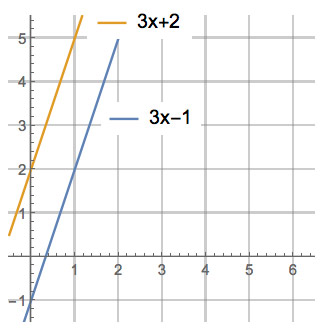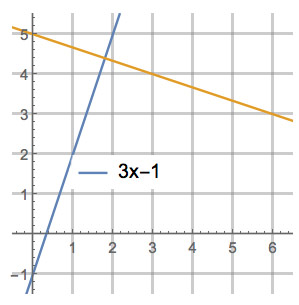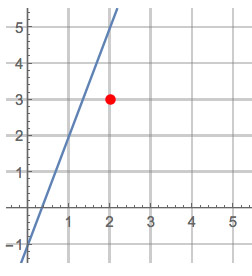05 Geometric Properties of Linear functions [1.5]
This week's lab: Due Tuesday.
Next class: Lab on Tuesday, 11 AM, GL 102.
[1.5]
Geometric Properties of Linear Functions
Basic Concepts
Given two linear functions: $$y_1(x)=m_1x+b_1;\ \ y_2(x)=m_2x+b_2$$
 When are their graphs parallel?
When are their graphs parallel?
 when $m_1=m_2$.
when $m_1=m_2$.
 When are their graphs perpendicular?
When are their graphs perpendicular?
 when $m_1m_2=-1$.
when $m_1m_2=-1$.
When do their graphs intersect?
- Either $m_1 \neq m_2$, or
- $m_1=m_2$ and $b_1=b_2$
At how many points can two lines intersect? 0? 1? 2? infinite?
Example 1
 Consider the line $f(x)=3x-1.$
Consider the line $f(x)=3x-1.$
Find a line that is both: parallel to $y(x)$, and goes through the point $(2,3)$.
Algebra approach
We know the slope of the line, $m=3$, and one point on the line, $(2,3)$. Use our approach of substituting the $(x,y)$ values into the equation of a line: $$\begineq f(2)&=&b+3*(2)\\ 3&=&b+6\\ \endeq $$ Subtracting 6 from both sides, we find $b=-3$ and the answer is $$\color{blue}{f(x)=-3+3x}.$$
Find a line that is both: perpendicular to $f(x)=-1+3x$, and goes through the point $(2,3)$ and graph both.
Algebra #1
Slope + point: $$\begineq f(2)&=&b-\frac13*(2)\\ 3&=&b-\frac23\\ \endeq $$
The solution is $$\color{blue}{f(x)=\frac{11}{3}-\frac{1}{3}x}$$
Algebra #2
We know the slope should be -1/3. All the $(x,y)$ points on the line must have the same rate of change relative to $(2,3)$. The way you calculate the rate of change is: $$\begineq m=-\frac 13 &=&\frac{y-3}{x-2}\\ -\frac 13(x-2)&=&y-3\\ -\frac 13x+\frac 23+3&=&y\\ \color{blue}{-\frac 13x+\frac{11}{3}}&=&y \endeq $$Example 2
A power company offers residents of a certain area the following options for supplying electric power: Which option is best?
- A flat fee of $180 per month regardless of how much power you use.
- A flat fee of \$50 per month, plus \$0.12 per kWh.
- $0.21 per kWh with no monthly fee.
What shall we call the dependent variable? [What do we want to compare?]
What is the independent variable? [What and determining our total cost?
For example, Call the number of kWh used per month "$k$". Call the cost of using $k$ kWh in a month $C_1(k)$, $C_2(k)$, $C_3(k)$, and graph. [WA]
Example 3
Graph $y=-2$ and $x=1$. Are either of these functions?
Suppose $f(x)=7$. What is $f(3)$.